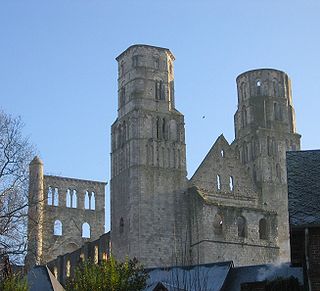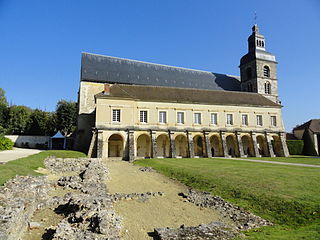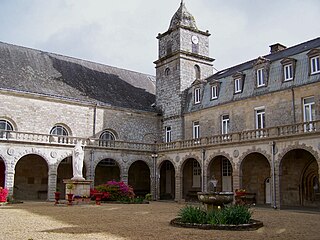Related Research Articles

Jumièges is a commune in the Seine-Maritime department in the Normandy region in north-western France.

Val-Dieu Abbey is a former Cistercian monastery in Wallonia in the Berwinne valley near Aubel in the Pays de Herve.

Alet Cathedral was a Roman Catholic church located in the town of Alet-les-Bains in Languedoc, France. The cathedral is in the Gothic architectural tradition.

La Cambre Abbey or Ter Kameren Abbey is a former Cistercian abbey in the City of Brussels, Belgium. It is located in the Maelbeek valley between the Bois de la Cambre/Ter Kamerenbos and the Ixelles Ponds. The abbey church is a Catholic parish of the Archdiocese of Mechelen–Brussels and home to a community of Norbertine canons, while other parts of the monastery house the headquarters of the Belgian National Geographic Institute (NGI) and La Cambre, a prestigious visual arts school.

Orbais-l'Abbaye is a commune in the Marne department in north-eastern France. The abbey at Orbais was founded at the end of the 7th century by Saint Réol, and the remains are situated in the centre of the town.
Gerald of Sales was a French monastic reformer from Salles, Lot-et-Garonne near Bergerac, Dordogne in the south-west of France. His feast day is on April 20.

Vaux-de-Cernay Abbey is a former Cistercian monastery in northern France (Île-de-France), situated in Cernay-la-Ville, in the Diocese of Versailles, Yvelines. The abbey was abandoned during the French Revolution and fell into partial ruin. Most of the buildings, except for the church, were restored in the late 19th century by Charlotte de Rothschild, and the property is now a hotel.

L'Étanche Abbey is a former Premonstratensian monastery founded in the 12th century, the ruins of which are near the modern village of Deuxnouds-aux-Bois, in the commune of Lamorville, Meuse, France.

Maubuisson Abbey is a Cistercian nunnery at Saint-Ouen-l'Aumône, in the Val-d'Oise department of France. It was founded in A.D. 1236 by Blanche of Castile, Queen of France, who may have been buried there in 1252. The site is now within the north-western suburbs of Paris. The surviving buildings are listed as a monument historique.

Saint-Yved is a church in Braine, Aisne in which the Counts of Dreux are buried. It was dedicated to Saint Yved, whose relics were brought to Braine (Braisne) in the ninth century. Originally a chapter of secular canons, the Braine Abbey was given to the Premonstratensian order by the Bishop of Soissons in 1130.

Hautvillers Abbey, or more formally the Abbey of St Peter, Hautvillers, is a former Benedictine monastery in the Hautvillers commune of the Marne department in north-eastern France. The abbey remained active between 665 and the French Revolution of 1789. It housed the relics of Saint Helena, Empress and mother of Constantine, between 841 and 1819. One of its monks, Dom Pérignon, contributed to the development of sparkling wine in the Champagne region. The building has been classified as a monument of historical value since 1983.

The Abbey of Saint-Sauveur-le-Vicomte, located in the commune of Saint-Sauveur-le-Vicomte in the Manche department of France, was a Benedictine monastery founded in the 11th century by Néel de Néhou, Vicomte of Saint-Sauveur. The abbey has longstanding connections with the nearby Channel Islands. After being dissolved in the French Revolution it became in the 1830s the mother house of the Sisters of Christian Schools of Mercy, now the Congregation of Saint Marie-Madeleine Postel.

The Abbey of the Holy Trinity is an 11th century Romanesque Benedictine Abbey church located in Lessay, Manche, France, then in Normandy. The abbey is one of the most important Norman Romanesque churches, and, along with Durham Cathedral, one of the first examples use of the rib vault to cover the choir in about 1098. This element became a key feature of Gothic architecture. The abbey was nearly destroyed in 1357. It was destroyed in 1944 and subsequently rebuilt.

The Abbey of Saint-Seine is a former Benedictine monastery located in Saint-Seine-l'Abbaye, Côte-d'Or, Burgundy, France. During the Middle Ages it was a wealthy and powerful institution. It was suppressed at the French Revolution.

Valsery Abbey is a former Premonstratensian abbey located in Cœuvres-et-Valsery, Aisne, France. It was founded in 1124 near the Forest of Retz, which the Premonstratensian canons doubtless helped to clear.

Fontenelles Abbey or Les Fontenelles Abbey was an Augustinian monastery in the former commune of Saint-André-d'Ornay, in the Vendée, France.

Dalon Abbey is a former Cistercian monastery in Sainte-Trie, Dordogne, southwestern France. It is listed as a Historic Monument.

Langonnet Abbey, formally the Abbey of Notre-Dame de Langonnet, which became the Langonnet stud farm between 1807 and 1857, is a former Cistercian abbey belonging to the diocese of Quimper. It is located in the Gourin deanery, east of the village of Langonnet, on the road to Plouray. It now belongs to the Congrégation du Saint-Esprit. It was listed as a monument historique by decree on September 25, 1928. Its ogival-style chapter house dates back to the 13th century.
References
- 1 2 Data.BNF.fr: Abbaye Notre-Dame d'Abbecourt. Orgeval, Yvelines
- 1 2 Base Mérimée : Abbaye de Prémontrés Notre-Dame-d'Abbecourt , Ministère français de la Culture. (in French)
- ↑ Merlet, L., Moutie, A., Cartulaire de l'abbaye de Notre-Dame des Vaux de Cernay: 1301-1635, (1858), vol.2, p.329
- ↑ Honoré Fisquet, La France pontificale, (1864), pp.543 et seq.
- ↑ Charpentier, F., Daugy, X., Sur le Chemin des abbayes de Picardie. (2008), p.135
- ↑ Migne, J.P., Dictionnaire de géographie sacrée et ecclésiastique, (1849), p.19
- ↑ Google Books: PARIS ÎLE DE FRANCE 2016/2017 Petit Futé: Dominique Auzias, Jean-Paul
- ↑ Bonnet, Ph., Les constructions de l'ordre de Prémontré en France aux XVIIe et XVIIIe siècles, (1980), pp.103-104